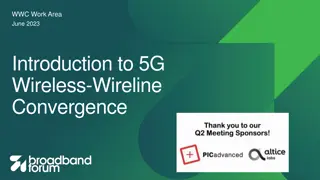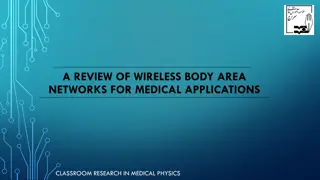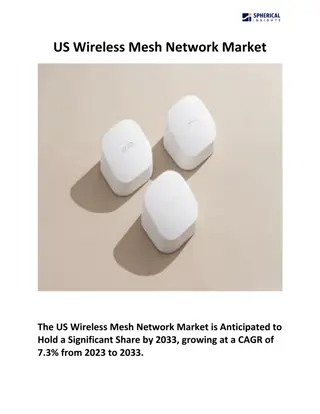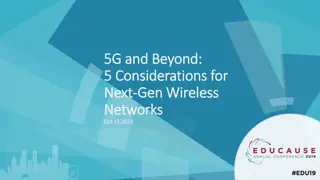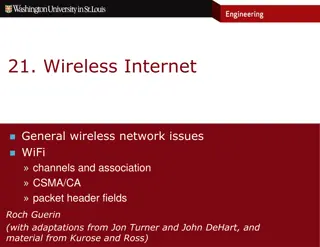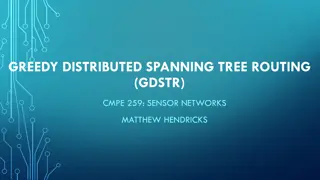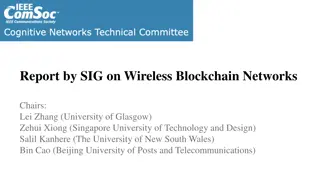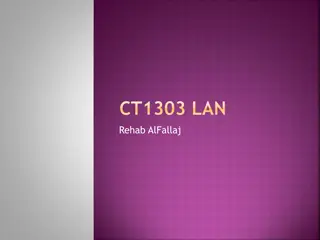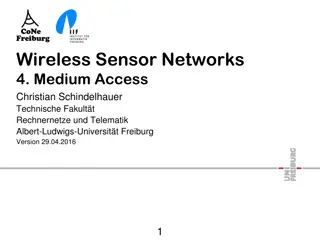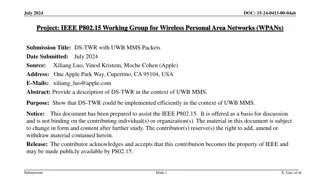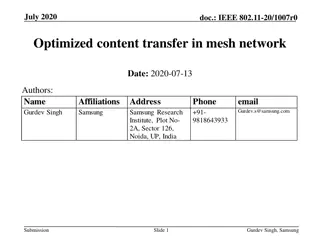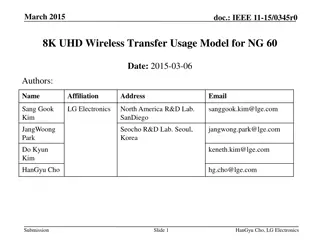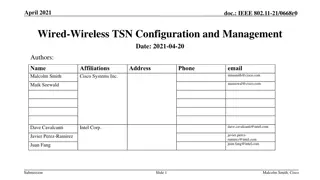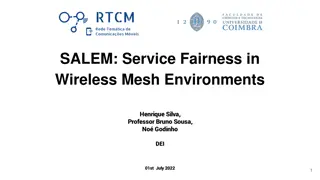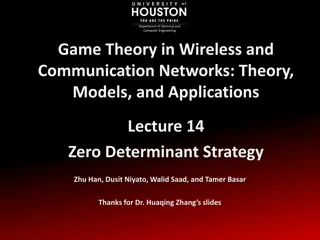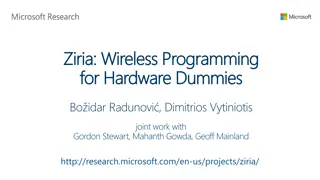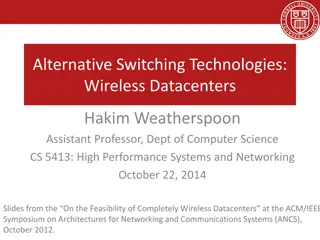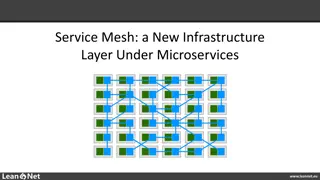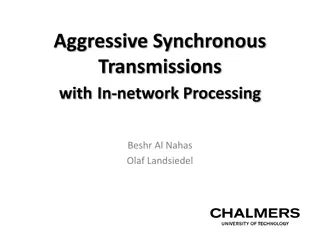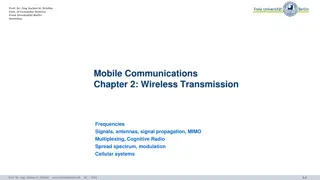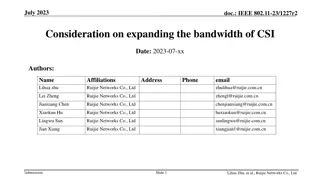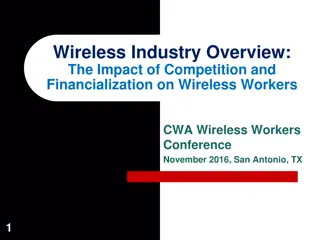Enhance Your Wireless Range: 192.168.188.1 Wireless Extender Setup with Top Apps
Are you tired of weak Wi-Fi signals limiting your internet access? Fear not! With the 192.168.188.1 Wireless Extender Setup and some top-notch apps, you can extend your wireless range and enjoy seamless connectivity throughout your home or office.\n\nfor more info: https:\/\/1921681881.com\/192-168-
6 views • 2 slides
Scrolls:Rolling Flexible Surfaces for Wideband Wireless
Revolutionizing wireless communication, the Scrolls project introduces rolling flexible surfaces for wideband wireless applications. With the expectation of 30 billion wireless devices by 2025, the project emphasizes standards and frequencies such as Cellular, Wi-Fi, and IoT. By offering a standard-
2 views • 19 slides
Understanding Wireless Communication Networks by Dr. K. Gopi at SITAMS
Wireless Communication Networks (WCN) is a fundamental aspect of modern telecommunication, allowing information transfer without physical connections. Dr. K. Gopi, an Associate Professor at the Department of ECE at SITAMS, introduces concepts like multiple access techniques, traffic routing, and the
1 views • 13 slides
Evolution of Wireless-Wireline Convergence in 5G Networks
The convergence of wireless and wireline networks in the context of 5G brings about significant changes and improvements. This evolution involves the integration of 5G core networks, new access network functions, enhanced interfaces, and the introduction of new devices like 5G residential gateways.
7 views • 25 slides
Understanding Computer Networks: Basics, Components, and Topologies
Computer networks are essential for sharing resources, exchanging files, and enabling electronic communications. This includes components like senders, receivers, messages, transmission media, and various modes of communication. The need for networking arises from file sharing, resource sharing, com
14 views • 28 slides
Exploring the impact of automated indexing on completeness of MeSH terms
This study delves into the effects of automated indexing on the thoroughness of MeSH terms. It addresses the novelty of automated indexing, its implications for teaching, questions raised by students, observed missing index terms, and the significance of MeSH in practice. The explanation of how auto
4 views • 33 slides
A Review of Wireless Body Area Networks for Medical Applications
Recent advancements in MEMS technology, integrated circuits, and wireless communication have enabled the development of Wireless Body Area Networks (WBANs) for ambulatory health monitoring. This paper discusses the infrastructure, in-body antenna design, low-power MAC protocol, and various applicati
1 views • 23 slides
US Wireless Mesh Network Market
The US Wireless Mesh Network Market is Anticipated to Hold a Significant Share by 2033, growing at a CAGR of 7.3% from 2023 to 2033.\n
0 views • 4 slides
Understanding Artificial Neural Networks From Scratch
Learn how to build artificial neural networks from scratch, focusing on multi-level feedforward networks like multi-level perceptrons. Discover how neural networks function, including training large networks in parallel and distributed systems, and grasp concepts such as learning non-linear function
1 views • 33 slides
Understanding Mesh and Star Network Topologies
Network topology plays a crucial role in network performance and maintenance costs. Mesh topology connects every device with a dedicated link, providing reliability and security. On the other hand, star topology connects devices to a central hub, ensuring communication through the hub. Explore the a
0 views • 22 slides
Rate Optimization in Wideband RIS-assisted Wireless Systems
This research focuses on rate optimization in wideband RIS-assisted wireless systems, specifically investigating MIMO RIS-assisted systems in sub-6 GHz mmWave settings. Pathloss and blockage modeling, along with LOS vs. spectral efficiency and RIS-UE distance vs. spectral efficiency analyses, are ke
0 views • 4 slides
Understanding Wireless Wide Area Networks (WWAN) and Cellular Network Principles
Wireless Wide Area Networks (WWAN) utilize cellular network technology like GSM to facilitate seamless communication for mobile users by creating cells in a geographic service area. Cellular networks are structured with backbone networks, base stations, and mobile stations, allowing for growth and c
2 views • 17 slides
Exploring Considerations for Next-Gen Wireless Networks
Emerging technologies and user behavior are driving the demand for advancements in wireless networks, particularly in the context of 5G and beyond. This presentation delves into key considerations such as the role of universities, drivers of 5G development, near-term technologies, infrastructure opt
0 views • 25 slides
Incidence of Mesh Fractures in Open Ventral Hernia Repair with Mediumweight Polypropylene Mesh
This study aims to characterize the occurrence of mesh fractures in open ventral hernia repair using mediumweight polypropylene mesh and identify associated risk factors. The research focuses on patients at Cleveland Clinic from January 2014 to April 2022, emphasizing retromuscular placement and a o
1 views • 19 slides
Hastelloy Wire Mesh Durable and Reliable
The Hastelloy wire mesh available at Nickel-wiremesh.com is of exceptional quality and durability. An ideal choice for commercial and industrial applications.\n\n\/\/nickel-wiremesh.com\/application\/hastelloy-mesh\/
3 views • 1 slides
Tamper-Evident Pairing (TEP) Protocol for Secure Wireless Pairing Without Passwords
This article discusses the challenges of traditional secure wireless pairing methods that rely on password validation and proposes the Tamper-Evident Pairing (TEP) protocol as a secure in-band solution to protect against Man-in-the-Middle (MITM) attacks. TEP eliminates the need for out-of-band chann
1 views • 40 slides
Enhancing Throughput in Multi-Hop Wireless Networks Using Reconfigurable Antennas
In this study presented at IEEE SECON 2018, the authors investigate the throughput limits of multi-hop wireless networks employing reconfigurable antennas (RAs). Challenges such as unreliable links, interference, and large overhead are addressed, with existing approaches at both the link/network lay
0 views • 29 slides
Exploring Wireless Technologies and Mobile Commerce
Delve into the realm of wireless technologies, mobile computing, and mobile commerce with a focus on the advantages and disadvantages of wireless transmission media, business applications of short-range to long-range networks, m-commerce benefits for businesses, technologies in pervasive computing,
0 views • 36 slides
Wireless Network Essentials and Classification
Wireless networks play a vital role in our modern world, with mobile devices outnumbering wired connections. This overview covers wireless network fundamentals, including elements, characteristics of wireless links, ad hoc operations, and network classifications like mesh networks and MANET.
0 views • 45 slides
Understanding Greedy Distributed Spanning Tree Routing in Wireless Sensor Networks
Wireless sensor networks play a critical role in various applications, and the Greedy Distributed Spanning Tree Routing (GDSTR) protocol, developed by Matthew Hendricks, offers an efficient routing approach. This protocol addresses challenges such as scalability, dynamic topologies, and sensor node
0 views • 34 slides
Report on Wireless Blockchain Networks by SIG Chairs
A detailed report by SIG Chairs Lei Zhang, Zehui Xiong, Salil Kanhere, and Bin Cao focusing on using blockchain for communication and optimizing blockchain performance in the context of 5G/6G networks. The report outlines the scope, team members, and upcoming activities related to Wireless Blockchai
0 views • 6 slides
Understanding Wireless Networks: Types and Applications
Wireless networks utilize wireless data connections to connect network nodes and share resources. They include Wireless Personal Area Networks (WPAN), Wireless LAN, Wireless WAN, Wireless Broadband, and Wireless Cellular. Each type has specific characteristics and applications, such as linking perso
0 views • 29 slides
Wireless Sensor Networks: Medium Access Protocols Overview
This collection of images presents key concepts in wireless sensor networks, focusing on medium access protocols, the ISO/OSI reference model, types of conflict resolution, contention-free protocols, Bitmap protocol, ALOHA algorithm, and its analysis and efficiency. Various protocols and algorithms
0 views • 83 slides
Efficient Implementation of DS-TWR with UWB MMS for Wireless Personal Area Networks
Description of DS-TWR in the context of UWB MMS, emphasizing its efficient implementation for Wireless Personal Area Networks. The document presents the necessity of DS-TWR in Mixed MMS for Ranging Integrity and summarizes its application with Mixed MMS in various scenarios involving packet transmis
0 views • 14 slides
Optimized Content Transfer in Mesh Networks Using Bandwidth-Aware Chunking
This presentation by Gurdev Singh from Samsung addresses a technique for optimized content transfer in mesh networks by splitting content into file chunks based on the bandwidth of the channel. By considering the bandwidth or link quality of destination nodes, the content is divided so that lower ba
0 views • 20 slides
Wireless Office Docking Model for Multiple Devices
This document outlines a usage model for office docking involving wireless connections between mobile devices and various peripheral devices such as monitors, hard drives, printers, and more. It describes scenarios for single and multiple devices in both home and office settings, emphasizing the nee
0 views • 5 slides
Evolution of 8K UHD Wireless Transfer Usage Model for Next Generation Displays
This IEEE document discusses the evolution of high-resolution displays and services, reviews wired interface solutions, and proposes a wireless transfer usage model for 8K UHD displays. It covers the advancements in display technology, including commercial 4K and 8K UHD offerings, broadcast services
0 views • 11 slides
Overview of External Wireless Communication System on International Space Station (ISS)
This presentation covers the overview and experience of implementing an external 802.11n wireless communication system on the International Space Station (ISS). It discusses the existing wireless system, committed users, system architecture, and future challenges. The system provides high data rate
0 views • 18 slides
Challenges and Solutions in Wired-Wireless TSN Configuration
This document discusses the challenges faced in configuring and managing wired-wireless TSN domains, focusing on the unique aspects of wireless networks such as fading, variable delays, and shared medium access. It presents models for physical and logical integration of wired and wireless TSN, empha
0 views • 13 slides
SALEM: Service Fairness in Wireless Mesh Environments
SALEM project focuses on managing resources intelligently in Wireless Mesh Networks to ensure fairness among services with heterogeneous technologies. Implementing a fairness model incorporating delay, reliability, and energy objectives, SALEM is tested in smart city scenarios. Through MILP optimiza
0 views • 11 slides
Understanding Network Analysis: Whole Networks vs. Ego Networks
Explore the differences between Whole Networks and Ego Networks in social network analysis. Whole Networks provide comprehensive information about all nodes and links, enabling the computation of network-level statistics. On the other hand, Ego Networks focus on a sample of nodes, limiting the abili
0 views • 31 slides
Game Theory Applications in Wireless Communication Networks
Explore the application of game theory in wireless communication networks through lectures covering various game theory concepts such as non-cooperative games, Bayesian games, and cooperative games. The focus is on Zero-Determinant Strategy, a method used for resource sharing and power control in wi
0 views • 36 slides
Wireless Programming for Hardware Dummies: Simplifying Wireless Research in the Industry
Explore the world of wireless programming for hardware beginners with a comprehensive guide on software-defined radios, FPGA usage, and modern wireless research challenges. Discover the importance of innovative PHY/MAC designs, new protocols like 5G and IoT, and the need for high-rate DSP in wireles
0 views • 76 slides
Exploring Wireless Technologies for Datacenters
This presentation delves into the feasibility and advantages of completely wireless datacenters, focusing on alternative switching technologies, goals, conventional setups, opportunities, 60GHz wireless technology, antenna models, design challenges, and the motivation behind moving towards wireless
0 views • 28 slides
Understanding Microservices and Service Mesh in Modern Cloud Architecture
Exploring the concepts of microservices and service mesh as crucial components in the evolution of cloud computing. Learn about the benefits of microservices architecture, the necessity of service mesh in managing complexity, and popular tools like Linkerd, Istio, and Envoy. Dive into the applicatio
0 views • 22 slides
Advanced Strategies for Wireless Communication Networks
Explore advanced strategies for wireless communication networks, including aggressive synchronous transmissions with in-network processing, goals beyond capture-based processing, concurrent wireless transmissions, and innovative concepts for efficient data transfer and network reliability. Dive deep
0 views • 11 slides
Understanding Wireless Communication Frequencies and Regulations
Explore the world of wireless communication frequencies, signals, and regulations explained by Prof. Dr.-Ing. Jochen H. Schiller from Freie Universität Berlin, Germany. Discover the various frequency ranges from VLF to EHF, examples for mobile communication frequencies, and regulations in Europe, U
0 views • 44 slides
Enhancing Bandwidth of Channel State Information (CSI) for Wireless Sensing Applications
This submission delves into the necessity of expanding the bandwidth of Channel State Information (CSI) in wireless environments to cater to the demands of time-sensitive wireless sensing applications. It explores the implications of high-bandwidth CSI on enhancing wireless channel understanding, ac
0 views • 12 slides
Understanding Interconnection Networks in Embedded Computer Architecture
Explore the intricacies of interconnection networks in embedded computer architecture, covering topics such as connecting multiple processors, topologies, routing, deadlock, switching, and performance considerations. Learn about parallel computer systems, cache interconnections, network-on-chip, sha
0 views • 43 slides
Overview of Wireless Industry: Competition and Financialization Impact on Workers
The wireless communications industry is rapidly evolving, with increasing data traffic, market penetration, and a shift towards wireless-only households. Major companies like AT&T, Verizon, Google, and Netflix are shaping the industry with a focus on network infrastructure and services. Despite the
0 views • 18 slides



